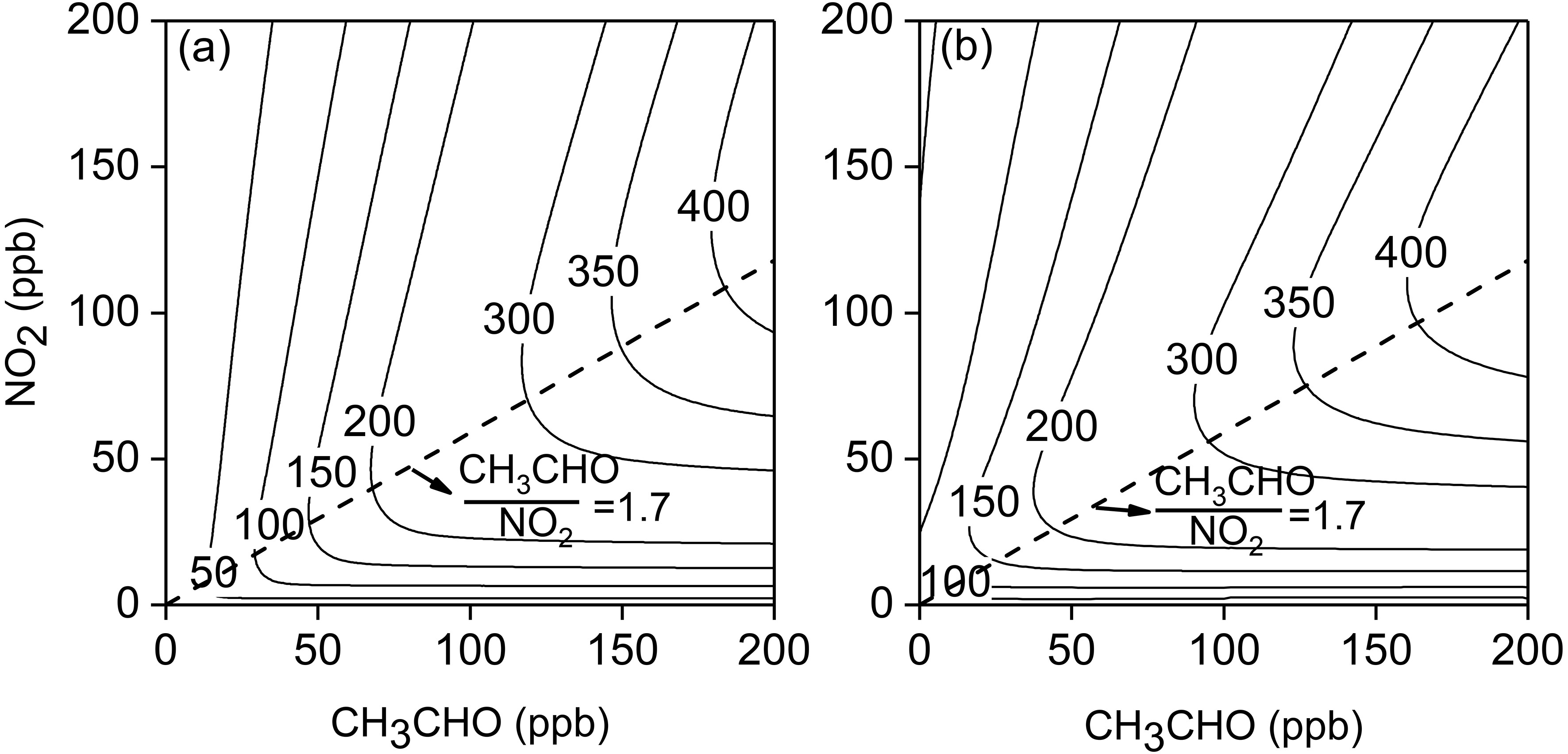乙醛是大气环境中重要的含氧的挥发性有机物(OVOC),是臭氧生成的重要前体物。目前已有研究表明,在部分城市地区乙醛对臭氧污染的贡献已经高于其他OVOC。然而,目前关于乙醛光化学反应的烟雾箱实验研究较少,仅有的实验研究主要关注在低相对湿度(RH)条件下不同光照强度对乙醛光化学反应臭氧生成的影响,而关于RH和反应前体物浓度比值的影响规律目前仍未见报道。此外,目前广泛应用的近显式化学反应机制MCM(Master Chemical Mechanism)对乙醛光化学反应的模拟准确性仍然有待评估,并且由于乙醛同样是其他VOC物种光化学反应的中间产物,因此MCM机理对乙醛光化学反应模拟的准确性显得尤为重要。本研究结合烟雾箱实验和数值模拟方法对乙醛光化学反应过程进行了详细研究。
烟雾箱实验表明,反应初始VOC/NOx比值对乙醛光化学反应中臭氧生成浓度具有显著影响,反应第6 小时生成臭氧浓度在低RH(RH = 11.6%±1.1%)和高RH(RH = 78.8%±1.0%)条件下均随着初始VOC/NOx比值的增大呈现先增大后减小的变化趋势。在初始VOC/NOx比值小于3条件下,RH对实验中O3生成浓度没有显著影响,而在初始VOC/NOx比值大于3条件下,高RH对实验中O3生成浓度具有不利影响。与烟雾箱实验结果相比,MCM机理在低和高RH条件下对第6 小时臭氧生成浓度分别低估了24%−35%和17%−49%。在MCM 机理中增加气相过氧乙酰基硝酸酯光解过程,同时在烟雾箱辅助反应中增加反应器表面的HNO3光解过程后,MCM机理模拟第6 小时臭氧生成浓度与实验测量结果之间差异分别降低到了6%−26%(低RH)和10%−42%(高RH)。在不考虑其他VOC物种的影响条件下,采用改进后的MCM机理模拟乙醛最大臭氧生成潜势为4.0 ppb ppb−1。
Abstract: Acetaldehyde is one of the important VOC species of O3 precursors in the atmospheric environment. The influences of relative humidity (RH) and initial VOC/NOx ratio (RCN) on the formation of O3 are studied in smog chamber experiments, and the MCM v3.3.1 mechanism of acetaldehyde is modified based on the experimental results. In low-RH conditions (RH = 11.6%±1.1%), the O3 concentration at 6 h increases first and then decreases with the increase of RCN, and the RCN at the inflection point of O3 concentrations is 3.2. In high-RH experiments (RH = 78.8%±1.0%), variation of the O3 concentration at 6 h with RCN is similar to that in low-RH experiments, but the RCN at the inflection point is 2.8. RH has no significant effect on the O3 concentrations under low RCN (< 3), whereas it has a negative effect under high RCN (> 3). Compared with the experimental results, original MCM v3.3.1 greatly underestimates the O3 concentrations. Addition of both the photolysis process of peroxyacetyl nitrate and the photolysis process of HNO3 on the reactor surface into the original MCM can reduce the difference between the simulated O3 concentrations and the experimental results at 6 h from 24%−35% and 17%−49% to 6%−26% and 10%−42% under low- and high-RH conditions, respectively. The maximum incremental reactivity (MIR) of acetaldehyde simulated with the modified MCM is 4.0 ppb ppb−1 without considering the effect of other VOCs.
Zhang H.L., Xu Y.F., Jia L., and Xu M., 2021: Smog chamber study on the ozone formation potential of acetaldehyde. Adv. Atmos. Sci., 38(7), 1238−1251, https://doi.org/10.1007/s00376-021-0407-5
Related Posts:



